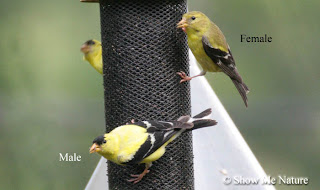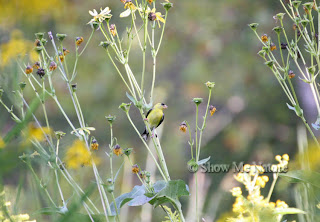What is your reaction when you hear
the word “spider”? Do you get a shiver down your spine? Do you feel fear or
admiration? There are often mixed reactions to spiders with movies and the media
adding to the misunderstanding of our arachnid friends. The point to
this entry is to educate readers on the natural history of spiders. You
may still not enjoy being around spiders after reading this blog entry,
but perhaps you will take pause and decide not to kill that 8 legged critter
scurrying up the wall.
Spiders are not insects. They belong
in the Arachnida class along with ticks, mites, harvestmen (daddy long legs)
and scorpions. There are about 40,000 known spider species. This is an impressive number, considering there
are only 4,000 species in the mammal kingdom. Missouri boasts 480 species of spiders.
 |
| Common Missouri Spider by Nancy Zuschlag. MDC Publication |
Arachnids have 8 legs and two body
parts, a cephalothorax (a fused head and thorax) and an abdomen.
Spiders have 8 eyes that are grouped in 4 pairs and despite all of those
eyes, their sight is poor. To compensate for their poor eyesight, the
body of a spider is covered in very sensitive hairs that pick up vibrations in
their surroundings and the air.
Spiders have fang-tipped jaws called
chelicerae. They use these fangs to inject venom into their prey
and to tear food apart before eating. Pedipalps, the limbs (they closely
resemble the spider’s legs, but are smaller) in front of the fangs are used for
reproduction, grabbing and killing their prey. Arachnologists
(scientists who study spiders) believe these limbs may also have a function
similar to antennae.
The abdomen contains the heart,
lungs, digestive tube and spinnerets. The spinnerets, found at the back
of the abdomen, produce silk. Spiders use this silk to create webs to trap
prey, use as safety lines during climbing, building homes, mating, and egg sacs
for their developing offspring. Incidentally, those newly emerged
spiders release silk that catches in the wind and carries them to their new
home.
 |
| Female Wolf Spider with eggs |
 |
| Spider eggs enclosed in silk. |
Believe it or not, those 8 legs of
the spider have their functions as well. Arachnids can hear, feel and even
smell with those legs. Their feet contain tiny claws that allow them to walk on
their webs, and walk up smooth surfaces.
All spiders eat bugs and insects but
they are separated into 2 different groups according to the way they catch
their prey. Hunters, such as Jumping Spiders and Wolf Spiders, do not
spin webs, but actively hunt and seize their prey. Trappers, such as
Garden Spiders and Trap Door spiders, made webs and lie in wait for their prey.
Let’s spend some time learning about
spider silk. Many arachnid species have been using the same genetic silk
recipe for the last 125 million years and for good reason. It has been
discovered that spider silk is more flexible than nylon and is five times
stronger than steel.
Everyone knows that spider webs are
made with silk. But what are the components of that web? Each web begins with a
single thread that the spider releases into the wind. This single thread forms
the foundation of the web. With any luck, the free end of the thread will catch
onto another branch. If the thread catches on to something, the spider cinches
the silk up and attaches the thread to the starting point. The spider walks
across the thread, releasing a looser thread below the first one. The support
structure of the web is formed when this thread is attached to both ends and
the spider climbs to its center. This is known as the frame thread. The
looser strand sags downward, forming a V-shape. The spider lowers itself from
this point, to form a Y-shape. The spider continues to create frame threads
between various anchor points. Then it begins to lay out non-sticky radius
threads from the center of the web to the frames. After building all the
radius threads, the spider lays more nonstick silk to form an auxiliary
spiral, extending from the center of the web to the outer edge of the web.
The spider then spirals in on the web, laying out sticky thread and using the
auxiliary spiral as a reference.
 |
| Biology of the Invertebrates, 4th edition. Jan Pechenik. |
Once completed, the spider
sits in the middle of the web and patiently waits for an unsuspecting insect to
fly into its trap. Once its prey hits the web, the spider will feel the motion
through the radius threads and make its way to the vibration source. These
spiders have the ability to tell the difference between vibrations from insect
prey and other sources (such as a breeze, or a leaf falling into the web). Many
species can also distinguish the characteristic vibrations of dangerous
insects, such as wasps.
 |
| Spider eating bee. |
Spider silk is a fairly new area of
study for Arachnologists and its use holds much promise for the human world.
In a 2002 issue of the Science journal, the US Army and a Canadian
biotechnology company reported that they had manufactured and spun the first
man-made fiber with mechanical properties similar to that of natural drag line
silk. Creating silk is difficult and time consuming (spiders only contain a
small amount of silk and mass rearing spiders is a difficult, if not impossible
undertaking) but this discovery opens up many potential applications of silk:
Body armor (similar to Kevlar), ropes, athletic attire, and medical device components. The list can go on and on.
All spiders have venom but in most
arachnids species the venom is not toxic to humans. These eight-legged
creatures prey on small insects and do not have the venom geared towards large
animals, such as humans. The mouth parts of a spider are not even capable of
piercing human skin. Most spiders do not want to bite, but in the unlikely
event that it does happen, it’s usually because a person steps on an arachnid
with a bare foot or reaches into an article of clothing that the spider
currently inhabits.
A great deal of research has gone
into spider bites and several studies have discovered that most “spider bites”
are not spider bites, but rather allergies, skin reactions, chemicals, biting
fleas or bedbugs, infections, poison ivy or oak, among other possibilities.
Although spiders may be hated and
are low on the cuteness meter, they play an important part in our world. That
pesky spider that has set up shop in the corner of your ceiling or the baseboard
may be preying upon unseen insects in your home, insects that are more likely
to bite humans. Spiders can also be a farmer’s best friend. Arachnologists have
estimated up to 11,000 spiders per acre in woodlands to more than 2.5 million
individuals in a grassland acre. Since each spider in a field may consume at
least one insect per day, their cumulative effect on insect populations is
significant. These hungry spiders prey upon grasshoppers, flies, moths,
caterpillars, leafhoppers, some bees and ants, and other spiders. If you still dislike the
spiders, think about this; spiders are an important food source for birds and
other animals.
Look for an upcoming entry on some of the spider species found in Missouri.
Glossary:
antennae: a pair of sense organs located near the front of an insect's head. Antennae are usually covered with receptors that can detect odors. Many insects also use their
antennae as humidity sensors, to detect sounds and some insects (flies) gauge air speed while they are in flight.
arachnid: A variety of arthropods of the class Arachnida, such as spiders,
scorpions, mites, and ticks. Arthropods are characterized by the absence of antennae, four pairs
of segmented legs and a body that is divided into two regions, the
cephalothorax and the abdomen.
genetic (genetics): The branch of biology dealing with heredity. Heredity is a biological process where a parent passes certain genes, such as eye and hair color, onto their children.
natural history: the study of animals and plants.
offspring: new organism produced by a living thing.
thorax: the middle region of the body of an insect.
venom: a poisonous fluid secreted by certain snakes and scorpions usually transmitted by a bite or sting.


















































